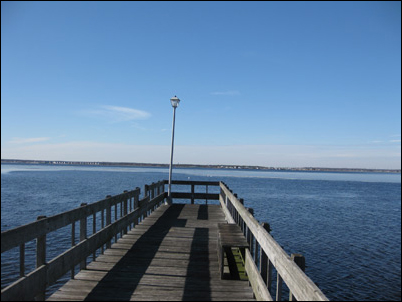
All Aboard
The importance of the Railroads
The early development and settlement of the New Jersey coast was strongly influenced by railroad access. Land speculators also played a big role in drawing people to the coast. Development typically took the form of the beginnings of a resort or planned community, which was a way of encouraging people to buy property. Yet the speculators' efforts would be fruitless if people could not easily reach these areas. The key was to have railroad access. Here we focus on some New Jersey railroad history that can help us understand events that led up to the development of Seaside Heights.
A portion of a map showing the railroads in New Jersey in 1869 highlights Barnegat Peninsula's isolation. The total absence of place names along the entire peninsula shows that there were no communities established at that time. There is a railroad spur ending in Toms River. This line began as the Toms River Railroad and connected with The New Jersey Southern Railroad’s main northeast/southwest line, which in turn ran into Philadelphia.
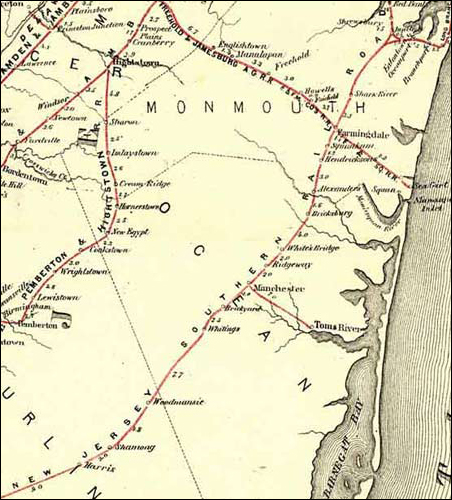
Railroad access and more about early New Jersey shore development
Train service to Atlantic City, Long Branch, Sea Girt and Cape May was already established by this time. The railroad lines to these shore towns were built to bring people to the beach. Land speculators and railroad companies both profited from these efforts. Train operators could charge passengers for their fares and the land speculators could earn handsome profits from their hotel businesses and land sales. Initial efforts taking place in 1869 were promising, leading to a few Jersey shore areas becoming increasingly popular vacation destinations.
These new coastal resort towns were already showing a pattern of development that would be repeated many times. First was the person, or group of people, that would buy a parcel of land. Remote properties that potentially could have a railroad built to them were the best speculative investments. The land investors were in some cases railroad owners or as part of their development scheme they formed their own railroad company.
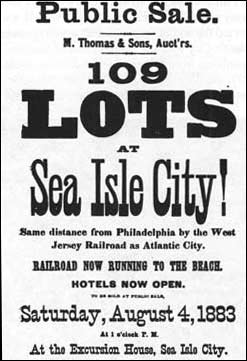
Building railroads was a highly competitive and potentially cut-throat business. Gaining a right of way from the government was vitally important. This alone was one part of that railroad business that was fraught with corruption and all manner of back room dealings. It was common at that time to sue rivals in order to try to keep them from building a line or connecting to other tracks. Legal actions were one set of tactics that could be used as a means of driving a competitor into bankruptcy. Many railroad companies were started and went out of business at this time. The failures ran the spectrum of how much they accomplished before becoming insolvent - from companies that never laid a tie to those that built track and ran trains. Failed companies with legally granted rights-of-way, half built track, or financially failing ongoing train operations were often eagerly scooped up by other railroads. Larger companies emerged out of the jumble of small organizations, slowly consolidating the many independent lines into what would become a few well known railroads.
Once a railroad was being built to a new shore location the land speculators would prepare for cashing in on their investment. A hotel would typically be in place by the time the railroad service began. Prospective buyers needed to have a place to stay so they could become enamored of the shore and have time to be enticed into buying a piece of property. Speculators also had to devise a development plan. This could be elaborate, as was the case with Atlantic City, or simply a plotted arrangement of lots that hinted at a more promising settlement. As the Jersey shore became more developed, building infrastructure and other amenities served an important role in attracting visitors and in competing with rival towns for attention. Bathhouses, pools, concerts and many other attractions were offered and heavily advertised.
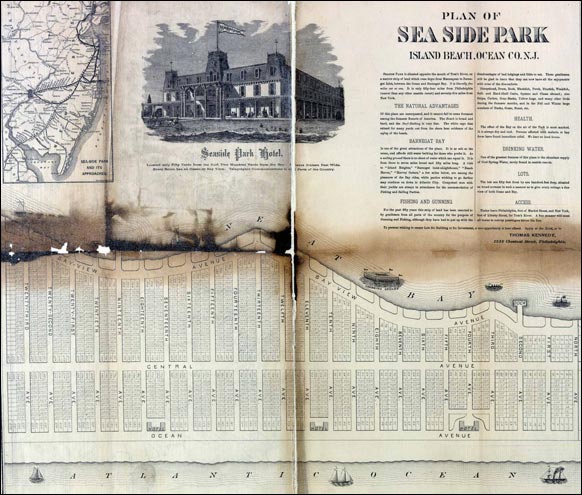
A typical flyer for a newly developing shore community. The hotel provides a place for perspective visitors to stay and the text explains, in grand terms, why this particular location is so special. This Seaside Park community plan includes arranged streets and lots that are described as "fifty feet front by one hundred feet deep, situated on broad avenues in such a manner as to give each cottage a fine view of both the Ocean and Bay." - Read more about Seaside Park's early development.
The process of turning the Jersey shore into a summer vacation land gained momentum as the railroads began to add more track. The Toms River spur that was present in 1869 was not as heavily used as a tourist line. It was primarily commercial, hauling goods that were brought into Toms River. The town had traditionally served as a hub for local commerce. Instead of goods being brought to the docks and shipped to markets by boat, they could now be loaded onto a train. Fresh seafood from the Toms River could now reach Philadelphia in less than a day.
Toms River and Barnegat Peninsula Railroads
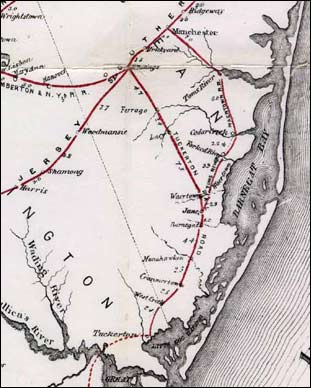
In 1873 we see the appearance of two railroad line spurs: the Toms River Waretown RR and the Tuckerton RR. It was hoped these trains would develop into prosperous passenger lines but they ended up being more important for commerce. Land development did not grow as fast as expected. The newer train lines passed through a number of small towns where the residents made their living from the bay, the sea and by harvesting other local natural resources. Wood, seafood, and other products could now be easily transported to Philadelphia from each of these towns. It is interesting that these working class towns were situated near, but not on, the barrier beaches. Before the railroads the earliest settlements in this area had begun and took root along the mainland side of Barnegat Bay.
A 1876 map shows no changes for Toms River but the Tuckerton line was by then connected to Long Beach Island. The railroad crossed the bay where the present day LBI causeway is located and then turned south. It ended at a terminal in Beach Haven.
A map from 1887, shown below, illustrates dramatic changes have taken place on Barnegat Peninsula. The railroad now crosses Barnegat Bay, connecting what is now Ocean Gate to the present day Fourteenth Street in Seaside Park. From there the track ran north, connecting to Point Pleasant and the Long Branch RR. The construction of the bridge and track were begun in 1881 and the entire line was completed in 1882. The railroad line was owned by the Toms River & Barnegat RR Co.
Now the area that was to become Seaside Heights was ripe for development. Despite the railroad access, it would still be some time before Seaside would become a tourist destination.
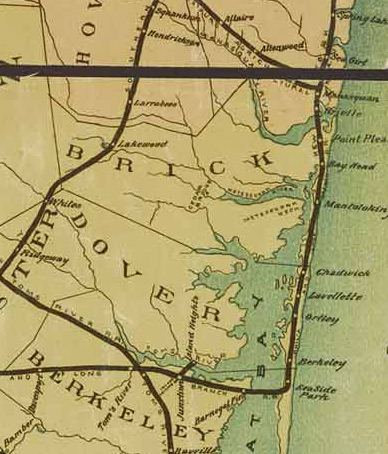
The railroad bridge over the bay is long gone, but today you can still see some of the bridge pilings near the shore of Barnegat Bay. The bridge remnants are readily visible from the bay shoreline in Ocean Gate, just to the south of Pier Ave. You can even, just barely, make them out on a satellite view of a Google map for this location. On the Seaside Park end there is now a dock at the bay end of 14th Street.
